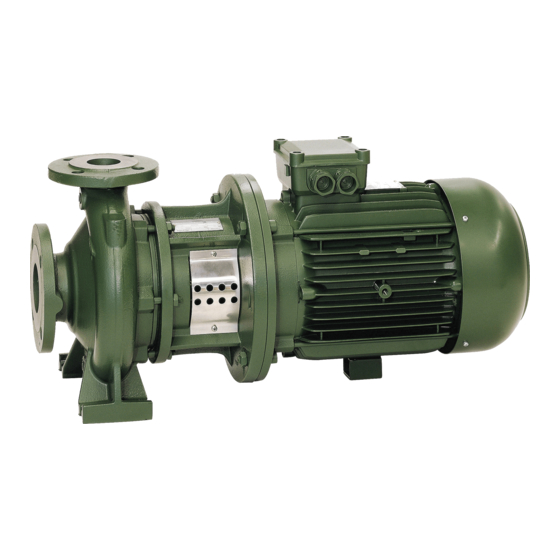DAB NKM-G 50-160 설치 및 유지보수 지침 - 페이지 8
{카테고리_이름} DAB NKM-G 50-160에 대한 설치 및 유지보수 지침을 온라인으로 검색하거나 PDF를 다운로드하세요. DAB NKM-G 50-160 20 페이지.

Example 1: installation at sea level and fluid at t = 20°C
Required N.P.S.H. :
Pb :
Hr:
t:
PV:
Z1
Example 2: installation at a height of 1500 m and fluid at t = 50°C
required N.P.S.H. :
pb :
Hr:
t:
pV:
Z1
Example 3: installation at sea level and fluid at t = 90°C
required N.P.S.H. :
pb :
Hr:
t:
pV:
Z1
In the last case, in order to operate correctly the pump must be fed with a positive head of 1.99 - 2 m, that is the free surface of the water must
be 2 m higher than the axis of the pump.
N.B.: it is always good practice to leave a safety margin (0.5 m in the case of cold water) to allow for errors or unexpected
variations in the estimated data. This margin becomes especially important with liquids at a temperature close to boiling
point, because slight temperature variations cause considerable differences in the working conditions. For example in
the third case, if instead of 90°C the water temperature reaches 95°C at any time, the head required by the pump would
no longer be 1.99 but 3.51 metres.
7.4.
Connecting auxiliary systems and measuring instruments.
The realization and connection of any auxiliary systems (washing liquid, seal cooling fluid, dripping liquid) must be considered when
designing the system. These connections are necessary for better and longer lasting pump operation.
In order to ensure continuous monitoring of the pump functions, it is recommended to install a vacuum pressure gauge don the intake
side and a pressure gauge on the delivery side. To check the motor load the installation of an ammeter is advised.
8.
ELECTRICAL CONNECTION
Scrupulously follow the wiring diagrams inside the terminal board box and those on page 1 of this manual.
8.1.
In the case of three-phase motors with star-delta start, ensure that the switch-over time from star to delta is as short as possible and
that it falls within table 8.1 on page 105.
8.2.
Before opening the terminal board and working on the pump, ensure that the power has been switched off.
8.3.
Check the mains voltage before making any connection. If it is the same as the voltage on the data plate, proceed to connect the wires
to the terminal board, giving priority to the earth lead.
8.4.
The pumps must always be connected to an external switch.
8.5.
The motors must be protected with special remote-control motor-protectors calibrated for the current shown on the plate.
9.
STARTING UP
9.1.
Before starting the pump, check that:
– the pump has been properly primed, filling the pump body completely. This ensures that the pump immediately starts to
work regularly and that the seal (mechanical seal or stuffing box seal) is well lubricated. Dry operation causes
irreparable damage to the mechanical seal and the stuffing box seal.
– the auxiliary circuits have been correctly connected;
– all the moving parts have been protected with suitable safety systems;
– the electrical connection has been made as indicated previously;
10.
STARTING/STOPPING
10.1.
STARTING
10.1.1.
Fully open the gate valve on intake and keep the one on delivery almost closed.
10.1.2.
Switch on the power and check that the motor is turning in the right direction, that is clockwise when viewed from the fan side. This
check must also be performed after having fed the pump, activating the main switch with a fast start-stop sequence. If the motor is
turning in the wrong direction, invert any two phase leads, after having disconnected the pump from the mains.
10.1.3.
Once the hydraulic circuit has been completely filled with liquid, gradually open the delivery gate valve until its maximum allowed
opening. The motor's energy consumption must be checked and compared with the value shown on the data plate, especially in
cases where the pump has intentionally been given a reduced power motor (check the design characteristics).
10.1.4.
With the pump running, check the supply voltage at the motor terminals, which must not differ from the rated value by +/- 5%
3.25 m
10.33 mcw
2.04 m
20°C
0.22 m
10.33 - 3.25 - 2.04 - 0.22 = 4.82 approx.
3.25 m
8.6 mcw
2.04 m
50°C
1.147 m
8.6 - 3.25 - 2.04 - 1.147 = 2.16 approx.
3.25 m
10.33 mcw
2.04 m
90°C
7.035 m
10.33 - 3.25 - 2.04 - 7.035 = -1.99 approx.
ENGLISH
19
